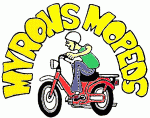Brief History of Mopeds in the USA
Author: Daven (m025001.sctcorp.com) Date: 02-22-2000 13:22
About the rise of mopeds in the 1970’s, and the fall in the 1980’s.
Among the many sorrows of 1995, America’s failure to celebrate the 20th anniversary of the arrival of the moped on its shores probably doesn’t rank very high. The oversight is, perhaps, even understandable. With their puny engines, fragile suspensions, and lumpy contours, mopeds were a paean to defensive driving, and as such, seem completely antithetical to what passes for a recreational vehicle today. Yet the moped was beloved. Twenty years ago, it was up there with hot tubs and Studio 54 on the top of the charts–a hallmark of its age. Since then, times have been tough. Even the recent 70s revivals have largely ignored the moped. Unresuscitated, unable to leap Travoltalike into our decade, the moped languishes in the dark recesses of the past, growing ever more obscure, fading like the leisure suit and Ben Gazzara. So quickly, before everyone who remembers the moped joins the Shah in the hereafter, indulge me, and to celebrate it. The semi-successful marriage of the motorcycle and the bicycle was first performed in gas-starved Europe at the end of WWII. Dubbed the moped (a contraction of the words motor and pedal), and basically unregulated, it flourished in the streets of Paris and Rome. The motors were very small (50 cc’s max) and of the simple two-stroke variety, so you had to mix the oil and gas yourself. But these spunky vehicles got ungodly mileage (between 100 and 200 miles per gallon). The pedals were used to help start the engine and to assist in hill climbing (although on some models, real hill climbing could be more easily accomplished by getting off the moped and walking). Those chic Europeans seemed to love them. But in America, mopeds were effectively barred by laws that classified them as motorcycles and demanded that they have foot brakes, turn signals, and various other features that they didn’t possess. We had to slake our thirst for this kind of machine with motor scooters and electric bikes. We probably didn’t even know we had such a thirst. Then in 1974, after a heavy industry lobby, the National Highway Traffic Safety Administration relaxed the safety standards for mopeds. The great American moped markets were open. Laws varied from state to state, but basically, the U.S. moped’s maximum speed was set between 20 and 30 miles an hour, and drivers were forbidden to enter major highways. Beyond that, the mid-70s moped laws were pretty lax. Many states didn’t require a license, insurance, or registration; some didn’t even set a minimum operating age–which was a blessing for eager-to-get-dating 15-year-olds. (The 30 mph top speed was somewhat elusive, since most models that could achieve that kind of speed tended to shake the fillings out of your teeth when they did it. Yes, these mopeds were slow, and their engines were meek.)
They came from strange-sounding companies at first: Puch, Garelli, Batavus, and Tomos, to name a few. But once the craze was on, many of the big motorcycle manufacturers joined the fray. The Honda Hobbit, introduced in 1978, may have been the quintessential moped in name and appearance (especially name). The consumer appeal was easy to grasp: The moped was cheap, very cheap. Cheap to operate, cheap to buy, and free to insure. You could get a good one for about $350. That’s $350 for a machine that could take you anywhere you wanted to go at 20 m.p.h., and make it seem like a good time if there weren’t too many hills or big trucks around. $350! I spend about seventy bucks a week these days just on cough medicine and phone calls to the Motorcycle Industry Council, never mind transportation. Moreover, the moped was fun to ride–it put you low to the ground with some wind in your hair and moved you through traffic sort of like a motorcycle did. And in a nation delirious about all sorts of moving vehicles and the trappings thereof (truckers and CBs, the Dukes of Hazzard and CHiPs, go-carts and slot-cars) the fun little moped fit right in. Sales jumped from 25,000 in 1975 to 75,000 in 1976 to 150,000 in 1977–and then doubled again in 1978. There were moped articles in every magazine from Newsweek to Glamour. They were popular with men and women, with the young and the old (and the very old, who liked to tool around retirement communities). They were sold in drugstores and newsstands, as well as your more conventional cycle shops, and everyone was back-ordered. Some high schools began to offer Moped Ed courses to eager freshmen. Nick Nolte and Jacqueline Bisset were in a ridiculous moped chase scene in The Deep. Jimmy Carter encouraged us to buy mopeds as part of his energy conservation program. And the Department of Transportation estimated that in the 1980s, America’s roads would be covered by two- to three-million mopeds.
But the good days didn’t last. Lawmakers began to consider the safety issues raised when a vehicle with a top speed of 30 m.p.h. mingles with normal traffic (acceleration at stop lights was a big problem). There were some accidents: not as many as with motorcycles, but there were a lot more safety laws for motorcyclists–including helmet requirements. And in a moped accident, the mopeder always seemed to lose. Furthermore, the police became troubled by the fact that mopeds, with licensing optional in most states, were a good means of transportation for people who’d had their automobile licenses revoked. Resulting legislation greatly increased restrictions on the mopeds. Alas, public perception changed too: The novelty wore off, and the moped became wimpy. Sales leveled, then declined, then dropped off the map. By 1985, there were fewer than 12 moped dealers in the country, down from a late 70s peak of several hundred. Moped madness was over.
